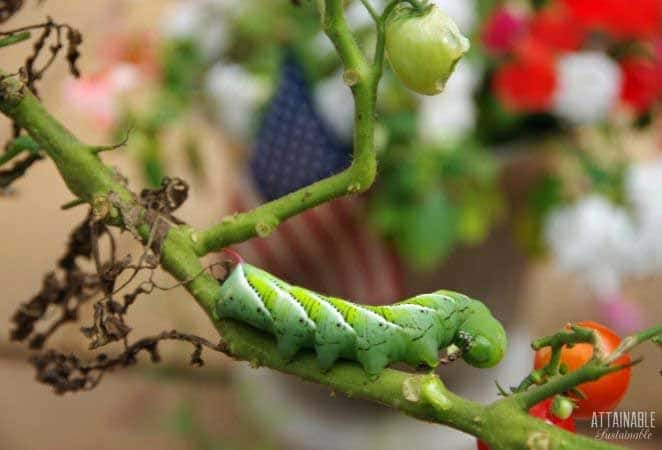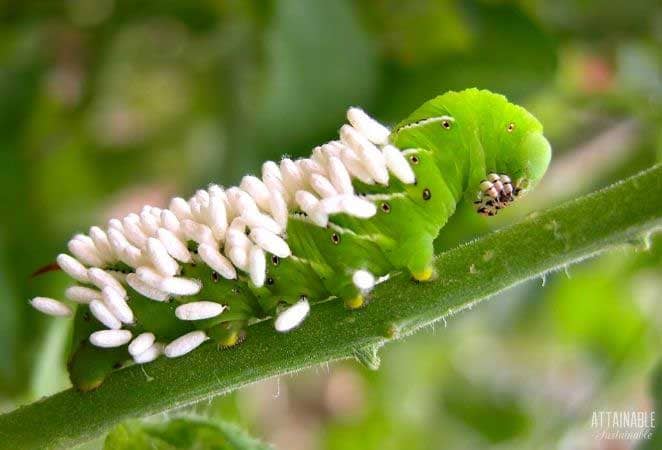Have you ever walked out into the garden to discover one of your tomato plants completely decimated? You’re likely looking at the work of a tomato hornworm.
Still learning about gardening? Check out this guide to growing Roma tomatoes in your garden!
Tomato hornworms (Manduca quinquemaculata) are often confused with the closely related tobacco hornworm (Manduca sexta). Both can cause plenty of damage to a tomato crop.
These pests are monsters, growing to 4″ long. Their bright green color allows these large caterpillars to blend in and become almost invisible on a tomato plant. You likely won’t see them until some damage is already done.
Understanding the Tomato Hornworm Life Cycle
Tomato hornworms are the larval stage of a night-flying hawk moth, or sphinx moth. These moths lay eggs on the leaves of tomato plants.
Small larvae — caterpillars — hatch from the eggs and quickly grow to full size. Once they’ve achieved full size, they burrow underground and pupate in the soil. Adult moths emerge in the springtime.
Grow Some Greens!
Ready to grow fresh greens, no matter WHERE you live? Sign up for my
FREE quick-start guide and start growing some of your own food!

Gardeners often unearth pupae while digging in the garden.
The hornworm pupa are about two and a half inches long and brown. They are sometimes unearthed by gardeners in the spring, before the weather has warmed enough to hatch.

Sphynx moths are often visible at night.
The Sphynx Moth (or Hawk Moth)
The moths that develop from the hornworm are large and beautiful, to be sure. And moths fall into the “pollinator” category and who wants to disrupt our pollinators? But left to their own devices, the hornworm is a huge impediment to growing tomatoes.
It’s a conundrum for gardeners, for sure, and there’s not a single right answer.
Hornworm Damage
These voracious pests can strip the leaves of a tomato plant overnight, impacting the plant’s health. The loss of leaves can also cause tomato fruit to sunburn in hot weather.
Larger caterpillars will also chomp through green tomatoes, making them inedible for humans.

Tomato hornworms can damage the leaves and fruit of plants.
Signs to Watch for
As the season progresses and warms, keep an eye on out for damage to tomato leaves. Bare stems are often the first indication that you have a problem.
Look more closely and you will see small, dark green caterpillar droppings. Small round clumps of poop cluster together to look almost like little grenades.
When you see poop, start looking for the elusive tomato hornworm grasping tightly to stems.
I’ve only recently discovered – thanks to one of my readers! – that hornworms will glow if you shine a black light on them. If you see signs of them but are unable to spot them during daylight hours, take a blacklight out after dark.
Combating Tomato Hornworms
The real question most people have is now that you’ve found them, how do you get rid of tomato hornworms?
There are a couple of options. If you have the space, you can plant several sacrificial tomato plants a short distance from your tomato patch. If you find hornworms on the tomato plants you plan to harvest from, relocate them to the sacrificial plants and let them go to town munching and crunching. They will continue their life cycle, you’ll still have tomatoes to harvest.
Not everyone has enough space to do this, though. If you have only a few tomato plants and are counting on those plants as food for the table, you’ll need to remove the caterpillar from the plant and interrupt its life cycle. If you keep chickens, they will make quick work of the problem for you.
Removing Hornworms
Once you spot the hornworms, removing them is the next step. They can cling quite tightly to the stems and leaves of the plant.
You can use pruners to clip off the leaf they’re on, but if the caterpillar is clinging to a bigger stem that you want to keep, you may have to pull them off. With your hand. Ew. Wear gloves.
Beneficial Insects
Another option is utilizing the idea of integrated pest management. This allows Mother Nature to handle problems without the use of harsh pesticides. [For more on natural pest control, go here.]
The relationship between the braconid wasp and tomato hornworms is a good example of this in action.
Female braconid wasps lay their eggs just under the skin of tomato worms. (I know, ew!)
When those eggs hatch, the larvae feed on the hornworm then make little white cocoons attached to the back and sides of the caterpillar’s body. If you see a sight like this in your garden, let the hornworm be. More wasps will hatch and continue to be a beneficial insect in your yard!
Using Row Covers and Sacrificial Plants
Reader Felycia Clifton shares her method:









Do I have to throw away the soil to completely get rid of tomato hornworms ?
It may take some time, but you shouldn’t have to. I’d try these methods and crop rotation before going to that length.
I use dill around my plants and don’t have a problem with them!!! And I love the smell of dill
Noted! Thanks for the tip 🙂
I use a UV flashlight and shine it on the plants in the late evening. The UV causes the Hornworms to be luminescent and glow which makes them easy to find as opposed to looking for them in daylight. If they have Braconid Wasp larva on them I do not kill them and instead take the worms to a place well away from my garden and leave them so the Braconid Wasp larvae continue to live on the Hornworms and produce more wasps that will eventually kill more Hornworms.
Using a UV flashlight is great tip. Thanks for sharing!